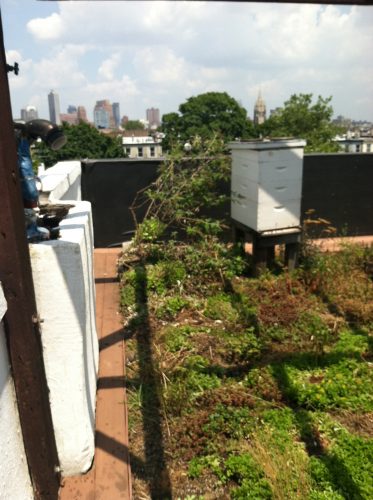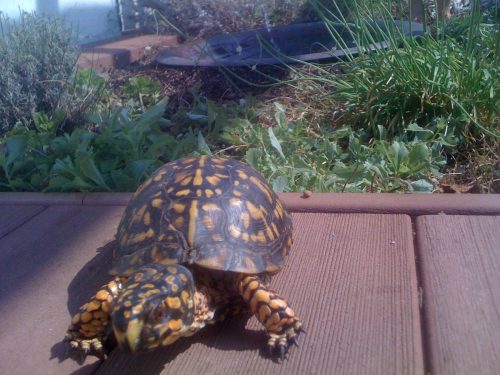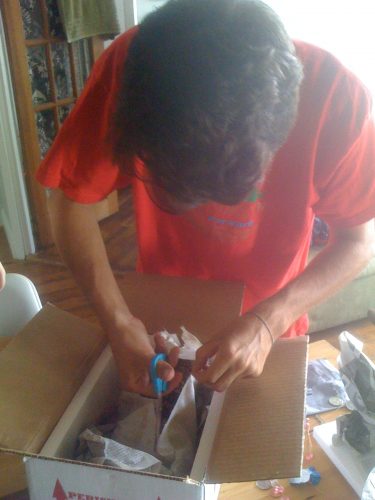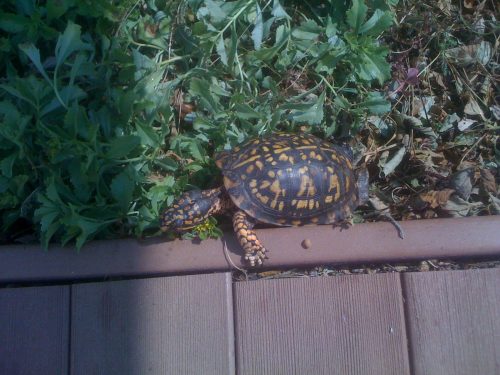If you were at the Eco Brooklyn Green Show House yesterday you would have seen a delivery man running briskly down the street with a white box in hand. On the box in big red letters were written “Attention: Non-harmful reptiles inside”.
Inside the box were two (one male and one female) Eastern Box Turtles and their arrival marked the end of many months of searching.

A while back we decided that native turtles would be a valuable addition to the green roof on top of the Green Show House. As ecological landscapers we don’t stop at native plants and organic compost. Our landscaping services attempt to rebuild natural ecosystems in harmony with the needs of humans. This involves creating water habitats and including larger native animals.
We also built an embankment with deep soil and a butterfly bush. This gives the turtles an area to burrow (which they do for large parts of the day) and shade.

Eco-Brooklyn attempts to create homes that lessen the barrier between “nature” and “human”; giving occupants a deep interaction with nature so that there can be more sense of harmony and connection with the world. The main example we have of this work is our Green Show House which doubles as a house and an office.
provide shade, water features, and hiding places for the turtles. Two Eastern Box Turtles are a vital addition to our green roof because they provide invaluable ecological and educational benefits.
The Eastern Box Turtle’s habitat is being threatened on many levels and box turtle populations are declining with many individual populations nearing extinction. The main problem they face is habitat destruction and fragmentation. Fragmentation refers to the separation of habitats by humans, such as the building of a highway through a forest could separate two turtle populations. This also means there is the potential to wander out of their habitat into human territory, where they are very vulnerable to accidental death by humans, especially as roadkill.
Our hope is that we can house these two turtles on the green roof so that they will eventually reproduce. On special occasions we will give them to other environmental organizations who have safe, contained outdoor habitats help reintroduce them back into the urban environment in a controlled way.
After our two turtles had arrived we discovered they had been captured from South Carolina and brought to the breeder in Las Vegas. This was a mistake on our part since it encourages wild catching, which further dwindles the wild populations.

It is also very important to tightly control interaction between captive and wild animals since they can transmit deadly diseases. It is possible to breed animals in captivity for repopulation of wild habitats but the process needs to be monitored closely to avoid spreading disease or disrupting native ecosystems.
The breeder, who was very helpful and clearly cared about his animals, assures us that he only breeds them in captivity now. Nonetheless, we feel the animal trade is no different than the slave trade: selling of life for ownership. Because of this, buying these box turtles was a necessary evil for us.
The turtles arrived in a small cardboard box. Inside was some Styrofoam insulation and crumpled newspaper. We removed the crumpled newspapers within the box to find a canvas bag tied with string. I cut the bag open and saw that there were two beautiful turtles in it. They popped out of their shells taking in their new surroundings.

Turtles in hand, the group scurried up to the roof to place them in their new habitat. We placed the turtles down and watched them nervously explore their new environment. They seemed to be a combination of excited and a little stir crazy from the shipment. After observing them for half an hour we retreated downstairs to do out work for the day; the experiment had begun.
It will be interesting to see how turtles react in an environment such as this. Ecologically, the turtles provide another component of the ecosystem, allowing for greater biological and ecological diversity. They have already begun to dig up the soil in search of worms, thus opening up spaces for weaker plants to grow as well as aerating the soil.
Educationally, we will be able to observe and disseminate information about how turtles interact with their environment in such a unique and interesting setting. We are excited to have our new housemates. They have been christened by Gennaro Brooks-Church’s four year old son with the names “Max” and “Ruby”.


